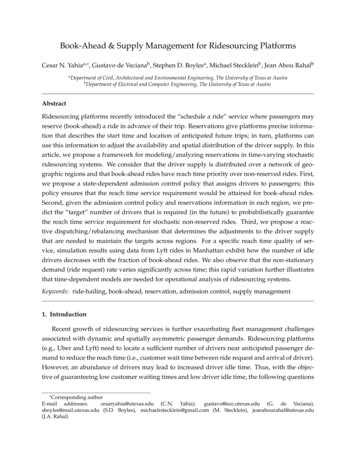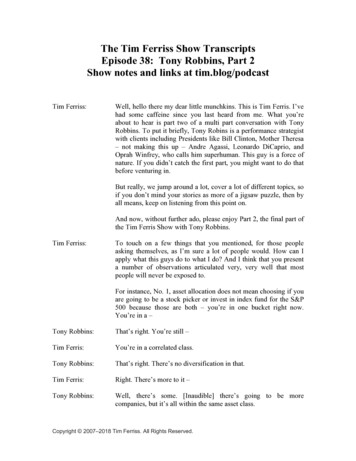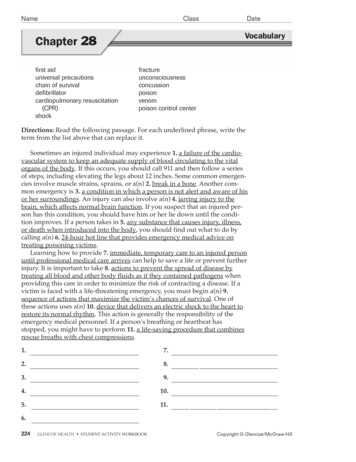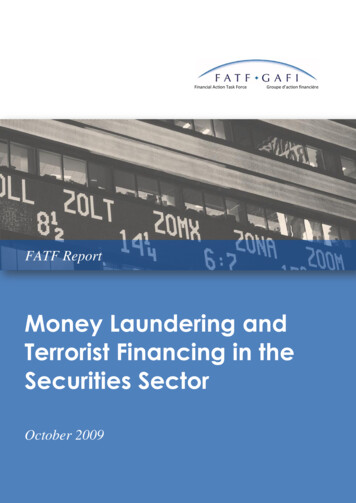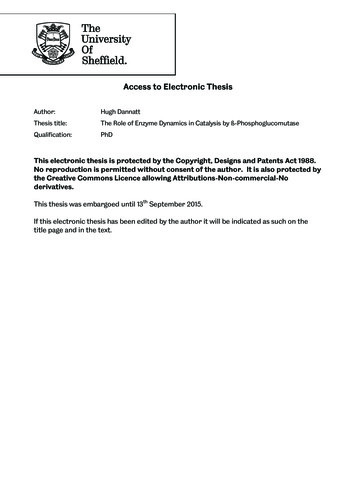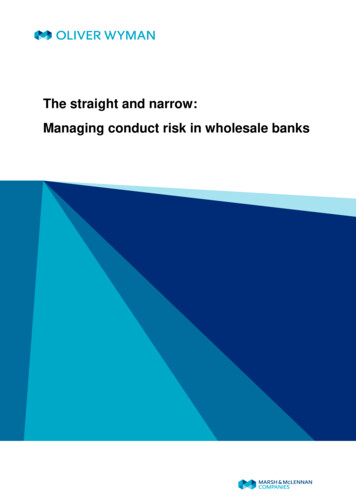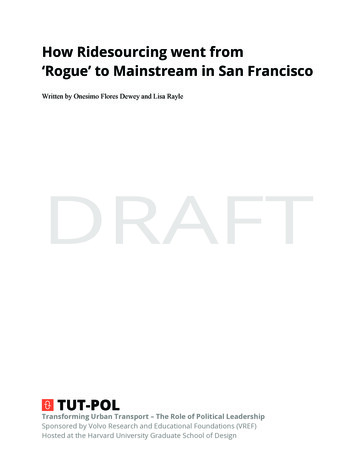
Transcription
How Ridesourcing went from‘Rogue’ to Mainstream in San FranciscoWritten by Onesimo Flores Dewey and Lisa RayleTransforming Urban Transport – The Role of Political LeadershipSponsored by Volvo Research and Educational Foundations (VREF)Hosted at the Harvard University Graduate School of Design
Table of ContentsIntroduction .1San Francisco, a City Where “You Couldn’t Get a Cab” .5THE RESILIENT TAXI MEDALLION SYSTEM .6The Limo and Black Car Industry .8Ridesourcing, Technically Possible and Financially Viable .9Sidecar . 10Lyft . 11UberCab . 12From UberCab to Uber . 13Uber-Competitive . 14Ridesourcing as a Rogue Operation . 15THE “SHARING ECONOMY” AND ITS POLITICAL ALLIES . 18An Unlikely Consensus in City Hall . 19RIDESOURCING FACES PUSHBACK FROM CPUC REGULATORS . 22MAYOR LEE ACTS . 24Risks and Draws of Supporting Ridesourcing . 25RIDESOURCING COMPANIES AS POLITICAL OPERATIVES. 26CPUC LEGALIZES RIDESOURCING. 28NEITHER TAXIS NOR LIMOS: Transportation Network Companies . 29Conclusion . 32Appendix I: Summary of Debate on Ridesourcing . 36Appendix II: Timeline of Events . 38This case was written by Onesimo Flores Dewey and Lisa Rayle for the project on “Transforming Urban Transport– the Role of Political Leadership,” at Harvard’s Graduate School of Design (GSD), with financing from the VolvoResearch and Educational Foundations (VREF). The author is responsible for the facts and the accuracy of theinformation in the case, which does not necessarily reflect the views of VREF or GSD. 2016 The President and Fellows of Harvard College.Draft: May 2016; Do Not Quote, Cite or Distribute Without Permission.
IntroductionThe advent of GPS, reliability of wireless internet, widespread usage of social media, andgrowing ubiquity of smartphones have given rise to a controversial new mode of urban transportthat we label ‘ridesourcing.’1 Ridesourcing occurs where travelers, using smartphone appsproviding real-time location and navigation information summon and pay for point-to-point ridessupplied by non-professional drivers of private vehicles.2 While its full effects on urban mobilityare largely unknown, ridesourcing is intensely debated around the world (see Appendix I forsummary). However, few can dispute that ridesourcing is a notable transportation innovation,featuring what Garrison and Levinson call the “silver bullet” combination of new technologyplus scale economies, from which virtually all major changes in transportation arise.3Smartphones and a smart matching algorithm efficiently guide drivers to waiting passengers.Drivers are attracted by the promise of revenue with no additional investment (though they doincur operating costs). Passengers flock to the service, attracted by its reliability (and often lowerprice) in relation to taxis, and by the convenience of point-to-point service relative to masstransit. Ridesourcing companies use demand-based pricing and passenger-driver ratings toimprove driver and passenger experience. The more passengers and drivers use the service, thelower the waiting times, attracting more of both.The emergence of ridesourcing has already disrupted the taxi industry, driving many companiesto rebrand themselves and adopt many of the features that make ridesourcing successful, such aselectronic dispatch, electronic payments, driver ratings, and app-based hailing. Only five yearsafter their founding in San Francisco, companies like Uber and Lyft have raised billions ofdollars from private investors,4 obtained regulatory legitimacy in many jurisdictions, launchedservices in more than 300 cities worldwide,5 enlisted hundreds of thousands of drivers,6 and1Lyft and Uber call their services “ridesharing,” but the term is inaccurate. Unlike ridesourcing, ridesharing is notconducted for profit and trips are incidental to the driver’s other trips, like carpooling. In ridesourcing, in contrast,drivers operate for profit, irrespective of their own destinations. The popular press often uses the term “ride-hailing,”but this could also apply to apps used to summon traditional taxis. We prefer “ridesourcing,” which we define assmartphone app-based ride services, offered for profit, not incidental to the driver’s trips, using personal vehicles.2Uber offers several options, which differ in each city. UberX, UberPop and UberPool, which rely on nonprofessional drivers and allow drivers to use their own vehicle, fit the definition of ridesourcing, while UberBlackand UberTaxi are not technically ridesourcing because they use professional drivers and dedicated vehicles.3Garrison, William L., and David M. Levinson. 2014. The Transportation Experience: Policy, Planning, andDeployment. Oxford University Press.4Uber, by far the largest of the three companies, is currently valued around 50 billion dollars, making it the secondhighest valued tech company based in San Francisco. By comparison, Twitter is valued at 23.9 billion. Manybelieve Uber is overvalued, but even with a 50 percent discount it would remain one of San Francisco’s mostvaluable companies. At the time of this writing, Uber has received 6.9 billion dollars from investors, Lyft 1 billionand Sidecar 35 million. (source: Crunchbase.com .5As of June 2015, Uber had launched ridesourcing services in 300 cities worldwide. Lyft operated in 60 US citiesand Sidecar in 10. Source: e.cr/about/ alanick/How Ridesourcing went from Rogue to Mainstream in San FranciscoTUT-POL Draft: May 2016; Do Not Quote, Cite or Distribute Without Permission.1
developed an enviable base of highly satisfied customers whose ranks continue to swell.According to a June 2015 national tracking poll, 12% of registered voters in the United Statesused Uber or Lyft applications “at least once a month,” and 3% “almost every day.”7 In urbanareas, 21% reported using Uber or Lyft at least once a month. In the San Francisco Bay Area, thefigures are even more impressive. By 2014, the yearly San Francisco Municipal TransportationAgency (SFMTA) survey reported that 25% of San Francisco residents used ridesourcingservices at least once a month, compared to 19% that used taxis as frequently.8 In the Bay Areacounties including San Francisco, ridesourcing accounts for an estimated 50,000 trips every day,compared to 22,000 by taxi. These achievements appear particularly remarkable in light of thefact that ridesourcing companies have been in the market for little more than five years, and thattheir services are available only to those with credit cards and smart phones.In nearly every city that Uber, Lyft, Sidecar, and other ridesourcing services haveentered, operators have faced an uphill battle, in large part because ridesourcing violated existingregulations and produced pushback from regulators and governing officials. As such, the arrivalof ridesourcing companies has also raised a series of public interest questions about liability,accountability, worker protections, and fair competition with taxis and limousines. For these andother reasons, established taxi interests, usually joined by local regulators, have foughtridesourcing tooth and nail. Outside the U.S., cities with stronger regulatory traditions, morerobust alternatives to automobile-based mobility, and highly organized taxi industries, like Parisand Seoul, have entirely banned ridesourcing services.9 Even in the US, where the prevailingculture and institutional structures tend towards greater skepticism of regulation and embrace ofentrepreneurship, the reception has at times been similar. For example, Portland, San Antonio,and Broward County (Fort Lauderdale)10 have cracked down on ridesourcing services, whileSeattle and New York,11 have attempted to adopt regulations intended to seriously constrainridesourcing growth.6According to the Taxi, Limousine, and Paratransit Association, there are about 171,000 taxis in the U.S. Sinceabout as many people use Uber and Lyft as taxis, and Uber and Lyft drivers are more likely to work part-time, it’splausible ridesourcing companies have hundreds of thousands of drivers. A study commissioned by Uber claims thatthe company had more than 160,000 active drivers in the United States at the end of 2014. “Active” in this studyrefers to completing at least four trips in one month (Hall and Kruger, 2015, p. 1-2). The same study claims thatbetween 2012 and 2014, the number of Uber drivers more than doubled every six months (ibid. p. 13). According tothe New York City Taxi and Limousine Commission, in March 2015, Uber had 14,088 black car vehicles in NewYork, more than the 13,587 licensed medallion taxis in the city. This does not count UberX (ridesourcing) vehicles,which represent the vast majority of Uber’s vehicles. sult.com/wp-content/uploads/2015/06/150505 crosstabs mc v2 AD.pdf, pg ravel-decision-survey-2014 -service-in-newyear.html? r 0; 150727-story.html11In New York, Mayor de Blasio introduced a City Council bill that would temporarily cap the number of new forhire vehicles, including Uber vehicles, while the city studied their effect on congestion. The mayor dropped theproposal after it provoked opposition from Uber supporters, who included Governor Andrew Cuomo, and after Uberagreed to provide the city data for its study. sioHow Ridesourcing went from Rogue to Mainstream in San FranciscoTUT-POL Draft: May 2016; Do Not Quote, Cite or Distribute Without Permission.2
Against this backdrop, the case of San Francisco stands out. It is where ridesourcing as a seriousbusiness began, and where a permissive regulatory structure first evolved. The regulatory patternfirst worked out there has since set the tone for many other large U.S. cities. Also noteworthy isthe fact that this evolution occurred relatively quickly and with minimal damage to the emergingindustry.Uber launched initially, in 2010, as an app exclusively using professional drivers of fullylicensed limos. Uber’s entry to the market raised few eyebrows in regulatory agencies. WhenLyft and Sidecar subsequently launched as ridesourcing platforms, in 2012, the governmentalresponse was much different. City and state regulators initially deemed ridesourcing illegal,viewing Lyft and Sidecar as types of taxi or limo services, and focusing on the fact that theirdrivers and vehicles lacked taxi medallions or limo licenses. Served with cease and desist ordersfrom local and state regulators, Lyft and Sidecar carried forth undeterred. The cease and desistorders ultimately went unenforced, and Uber reacted by launching its own ridesourcing service,UberX.In late 2013 the California Public Utilities Commission, permitted ridesourcing companiesunder a new regulatory category, Transportation Network Companies, enabling them to adddrivers and vehicles without limit and to determine fares, as long as they met, monitored, andenforced minimum requirements. Within less than a year, ridesourcing had become bothestablished and legal. Since then, many of the strategies first put in place in San Francisco havebeen replicated and refined in other cities, resulting in regulatory changes in 22 states based onCalifornia’s example.12In the upcoming pages we discuss the political actors and institutions involved in turningridesourcing in San Francisco from a rogue operation to mainstream service. Popular accountshave often focused on the companies’ lobbying skills and their tactic of rallying passengers anddrivers to sign petitions, contact government officials, and attend public meetings.13 Yet such anexplanation is far from sufficient. In San Francisco in 2012-2013 the companies’ lobbying“muscle” was not as developed as it is now. In this case, we will show that while lobbying anduser organizing were important to the successes of ridesourcing, so too were the responses andstrategic moves of a range of public sector actors, both elected and appointed, who pursued theirown set of interests.Furthermore, a set of contextual forces and conditions particularly salient in San Francisco werecritical, most notably the following: (1) mounting public frustration over serious shortcomingsof the taxi system, (2) the widespread availability of new and user-friendly communicationstechnologies that were familiar to a wide range of transportation users, and (3) city for-now.html? r 0). The Seattle story is detailed in the concludingsections of this case study.12As of July 2015, many cities as well as these 22 states had adopted regulations similar to California’s, andridesourcing has spread widely (in the face of varying levels of resistance) around the world.13See, for a good example, 38-95a187e4c1f7 story.htmlHow Ridesourcing went from Rogue to Mainstream in San FranciscoTUT-POL Draft: May 2016; Do Not Quote, Cite or Distribute Without Permission.3
growing embrace of new technology companies as key drivers of San Francisco’s prosperity andgrowth.There are several major groups of actors in this story—local transport and tech industry interests,career transport regulators, and their political superiors, both elected and appointed. The linebetween the private and public sector is complex in San Francisco, because tech executives andother corporate leaders often occupy seats on local planning bodies and quasi-public entities, andmany public officials share the perspectives and goals of local business leaders. But publicofficials often have to choose between private sector interests, and that was very much so in thiscase. We shall focus particularly on the central roles of San Francisco’s mayor, Ed Lee, and thePresident of the California Public Utilities Commission (CPUC), Michael Peevey.Mayor Lee’s office shielded ridesourcing operators from regulatory crackdowns from the SanFrancisco Municipal Transportation Authority (SFMTA), while shepherding the issue away fromthe local arena to the state level, where it found a far more receptive regulatory environment. Atthe state level, Public Utilities Commission (CPUC) President Peevey thwarted regulators in theSafety and Enforcement Division, the group responsible for issuing cease and desist notices toridesourcing companies as well as following up with citations. Peevey led the CPUC in creatinga new regulatory category, “Transportation Network Companies” (TNCs), with rules thatprotected basic consumer safety but effectively legitimized the once rogue ridesourcing services.The city never challenged the state over regulatory jurisdiction of the emerging service.In part, California’s choices reflected the political influence of the technology industry in the SanFrancisco Bay Area. More generally, however, the key decision makers viewed ridesourcing asa potentially transformative model for enhancing public mobility while strengthening SanFrancisco’s brand: technology and innovation. The next section portrays the context in whichridesharing arose. Subsequent sections tell the story of who clashed over ridesourcing and howridesourcing companies went from being stymied by intense resistance from a deeply entrenchedtaxi lobby and career regulators to winning a new regulatory categorization with the activeintervention of political leaders that allowed them to operate legally.How Ridesourcing went from Rogue to Mainstream in San FranciscoTUT-POL Draft: May 2016; Do Not Quote, Cite or Distribute Without Permission.4
San Francisco, a City Where “You Couldn’t Get aCab”By 2010, many San Franciscans had come to consider their city as one where “you couldn’t get acab.” A 2001 report commissioned by the San Francisco Planning and Urban ResearchAssociation (SPUR), reported that passengers calling on the phone for a cab had only a 40%chance of actually getting a ride.14 A similar study conducted at the end of 2005 concluded thatwhile taxicab availability was adequate at hotel stands and around the SFO airport, “phonereservations did not meet the response time goals set by the (Taxi) Commission.” 46% of thetaxis dispatched took longer than 30 minutes to arrive at the traveler pickup point.15 At the sametime, San Francisco taxi fares ranked “second highest in the country and fourth highest for longtrips.”16Jordanna Thigpen, who served as Executive Director of the city’s Taxi Commission in 20082009, recalls frequently receiving calls in the middle of the night from friends and family whocould not get a cab. Racial minorities and other marginalized groups were especiallyunderserved. She elaborated, “We did studies that showed taxis ‘never went out to Bayview,’” aneighborhood in San Francisco’s far southeastern corner that houses the city’s largest blackpopulation. “These communities didn’t have a voice. Elderly and disabled people couldn’t geta cab.” Charles Rathbone, a taxi company manager, added: “There wasn't very much that Icould do about it. We were blowing 50,000 orders a month at Luxor Cab because we justcouldn’t fulfill them. They would come through our dispatch system and they were lost. Youknow, we just couldn’t cover them.”Taxis should have been an important mode of travel in San Francisco, given the city’s relativeaffluence combined with compactness, low car ownership levels, and very high parking prices.The only U.S. city with a stronger taxi street hail market is New York.17 However, nonmotorized modes (walking, bicycling) and public transit lag as alternatives, the former due to thecity’s hilly topography and the latter due to the limited reach and capacity of existing networks.1814Of 588 test calls made, 170 were not even answered, and 20 callers were told there was no cab available. Of theremaining calls, just 237 cabs arrived, and there were 161 ‘no shows.’ (SPUR, 2001) -“Making Taxi Service Workin San Francisco: Final Report.” Nelson/Nygaard Consulting Associates. Prepared for San Francisco Planning andUrban Research Association November 2001: 9.15“Taxi Availability Study for PCN Determination.” Q2 Research Group. Prepared for the San Francisco TaxicabCommission. January 2006: 12.16“The San Francisco Taxicab Industry: An Equity Analysis”. Goldman School of Public Policy. Prepared for theHonorable Gavin Newsom. June 2006: 32.17Schaller, Bruce. 2007. “Entry Controls in Taxi Regulation: Implications of US and Canadian Experience for TaxiRegulation and Deregulation.” Transport Policy 14: 490–506.18Henderson (2013) describes how San Francisco halted highway construction projects, but failed to provideadequate alternatives in the form of transit or bikeways. The Bay Area Rapid Transit (BART) never attained thecoverage originally envisioned and serves only a single corridor within San Francisco proper. The San FranciscoMunicipal Railway (MUNI) maintains a relatively dense network of buses and streetcars, but capacity has lagged farbehind demand. A major barrier is the inability to finance transit projects.How Ridesourcing went from Rogue to Mainstream in San FranciscoTUT-POL Draft: May 2016; Do Not Quote, Cite or Distribute Without Permission.5
Taxi users have customarily been those at the low and high ends of the income scale;19 SanFrancisco has many of both. With the city’s population growth, especially among mid- and highincome professionals, demand for taxi-like services was growing, creating a widening gapbetween demand and what the taxi system could provide. On the supply side, the poorperformance of the taxi system in San Francisco, most notably the scarcity and low quality ofservice, was widely attributed to the taxi medallion system.THE RESILIENT TAXI MEDALLION SYSTEMMedallion systems in the U.S. date back to the Great Depression, when virtually all largeAmerican cities capped taxi supply so as to protect existing operators from the flood of newcompetitors who were suddenly entering the market.20 San Francisco’s particular version of themedallion system was significantly modified by a 1978 ballot initiative, Proposition K, followingthe bankruptcy of San Francisco’s largest taxi company, its inability to pay drivers’ benefitspackages, and subsequent questions about the sale and transfer of its 500 medallions. Pressed bythe company’s unionized drivers, the San Francisco Board of Supervisors passed an ordinancebarring corporate sales and transfers of the permits and providing that only individual taxicabdrivers could hold permits. Mayor George Moscone vetoed this ordinance, but the idea wasreintroduced as a ballot measure. With support from labor unions and other left-oriented groupsin the city, the measure passed, though with just a 51 percent majority.21 Prop K eliminated themarket value of taxi medallions and of course diffused ownership. Medallions could no longerbe sold and could be held only by working taxi drivers. Holders could retain them only so longas they continued personally to drive their taxis at least 800 hours per year.22Unable to monetize their medallions at retirement, holders retained them as long as possible,leading to an aging population of drivers as well as an extensive wait time (12-15 years) formedallion applicants, so that even new entrants to the industry tended to be relatively old.23Rather than disappear from this market, taxi companies found their niche in connectingmedallion holders with contract drivers (to supplement their own hours behind the wheel),leasing vehicles, and offering telephone dispatch services to drivers. The contract drivers, payingmore than 100 a shift in lease fees while lacking traditional employee benefits, were forced tocut corners to make ends meet and became notorious for aggressively soliciting tips, rejectingtrip requests to out-of-the-way locations, and refusing to accept credit cards.19Dempsey, Paul Stephen. 1996. “Taxi Industry Regulation, Deregulation, and Reregulation: The Paradox ofMarket Failure.” SSRN Scholarly Paper ID 2241306. Rochester, NY: Social Science Research Network.http://papers.ssrn.com/abstract 2241306.20Gilbert, Gorman, and Robert E. Samuels. 1982. The Taxicab: An Urban Transportation Survivor. Chapel Hill:University of North Carolina Press.21It was constitutional to forbid medallion sales because the medallions were public, renewable licenses, distributedby local governments to their holders for a small fee. Their value in the marketplace was simply attributable to thecaps that localities had placed on their number.22According to Mark Gruber, a longstanding spokesperson for the United Taxi Workers (UTW), “Proposition Kcreated a situation where drivers had a way to gain a stake in the industry without having to shell out a fortune ofmoney as was the case in other cities and as was previously the case in San Francisco.”23Hayashi interviewHow Ridesourcing went from Rogue to Mainstream in San FranciscoTUT-POL Draft: May 2016; Do Not Quote, Cite or Distribute Without Permission.6
For all its problems, the Prop K system withstood change for nearly two decades. It survived two1979 legal suits by Yellow Cab and other taxi companies,24 and several local ballot initiativesseeking to allow corporate entities to hold or own, and in effect (if not name) to sellmedallions.25 None of these efforts succeeded, as drivers, both medallion -and non-medallionholders, mobilized against them. Taxi drivers, despite their non-unionized status, formed aninformal alliance with labor unions26 that, while tenuous, helped protect the system in the laborfriendly Board of Supervisors. Further, taxi regulation fell under the purview of the SanFrancisco Police Taxi Detail, which periodically audited medallion holders to ensure they werefulfilling minimum driving hours and investigate public complaints about overcharging, poorservice, and lost or stolen items. In the late nineties, as complaints about inadequate serviceincreased along with burgeoning employment in the dot-com industry, Mayor Willie Brownspearheaded the creation of a city Taxi Commission. The Commission gradually increased thenumber of medallions from 981 in 199827 to 1,431 in 2007,28 but complaints of taxi shortagesduring busy periods were undiminished.A pivotal opportunity for taxi industry reform arrived with Proposition A in 2007 when MayorGavin Newsom (2004-2011) and the San Francisco Board of Supervisors proposed passingregulatory oversight of the industry from the Taxi Commission to the San Francisco MunicipalTransportation Authority (SFMTA) and identified the sale of taxi medallions by auction as apotential revenue stream for the City amidst a local and statewide public budget crisis.29 Transitlabor unions supported Prop A, judging that it would help resolve the budget crisis whileminimizing layoffs, but the taxi workers’ organization (the United Taxi Workers), which was nota union, opposed it, fearing that it would bring about a transition toward all taxi medallions beingsold and transferred on the market. As the debate raged,30 Newsom announced that he would run24In O’Connor vs. Superior Court (1979), the plaintiffs argued Proposition K involved an unconstitutional ‘taking’of private property. Citing precedent cases, the San Francisco Superior Court upheld Proposition K, concluding,“a license or permit to engage in the taxicab business, issued by the city pursuant to its police power, does notconvey a vested property right” and asserting, "[the] use of streets by taxicabs is a privilege that may be granted orwithheld without violating either due process or equal protection.” This ruling survived a series of appeals, and thelegal controversy died down after the Supreme Court refused to review the matter.25These were an(1993)andBrown(1996).26Prior to Prop K, drivers working for taxi companies were unionized, but after Prop K were no longer classified asemployees and could not legally form a union. The UTW was affiliated with the Communications Workers ofAmerica Local 9410. The UTW’s two attempts to file for union elections were denied by the National LaborRelations Board, who ruled the drivers were not employees. While the drivers did not attain legal status as a union,they were definitively organized. (http://www.taxi-library.org/history.htm)27Source: http://www.taxi-library.org/sf-pcn98.htm281,012 of these permits here held by individuals -most of them long time cab drivers. Taxi companies held the rest(grandfathered from the “pre-K” era). MUNI),whichfacedalargeandgrowingbudgetdeficit estimated to be around 30 million/year, .Source:. 11-01/proposition-muni-reform30Prior to its passage, UTW managed to obtain a verbal commitment from Mayor Gavin Newsom, Boardof Supervisors President Aaron Peskin, and SFMTA Executive Director Nathaniel Ford, that Prop Kwould be preserved even after the merger of the Taxi Commission with the SFMTA. However, followingthe completion of the merger in 2009, Mayor Newsom announced his intention to auction taxi medallionsHow Ridesourcing went from Rogue to Mainstream in San FranciscoTUT-POL Draft: May 2016; Do Not Quote, Cite or Distribute Without Permission.7
for Governor and turned his attention to campaigning.31 Consequently, the SFMTA appointed ataxi regulator, Christiane Hayashi, to find a solution that would satisfy all interests.32 Eighteen
By 2014, the yearly San Francisco Municipal Transportation Agency (SFMTA) survey reported that 25% of San Francisco residents used ridesourcing services at least once a month, compared to 19% that used taxis as frequently.8 In the Bay Area counties including San Francisco, rides

